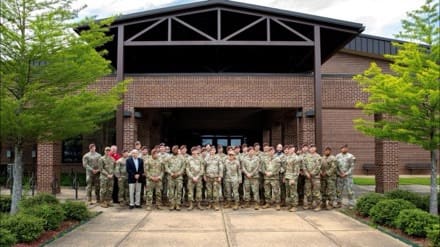
FORT MOORE, Ga. — Safety Pressure Help Command carried out a tabletop experiment on the Maneuver Battle Lab to arrange for future conflicts and warfighting wants from Could 13-17, 2024. It introduced advisors collectively from 1st, 2nd, third and 4th Safety Pressure Help Brigades to guage and improve their operational capabilities for 2030 and past, specializing in multi-domain operations and large-scale fight readiness throughout competitors, disaster and battle.
The first purpose of this train was for advisors to determine operational gaps and friction factors within the present doctrine or construction to boost readiness by offering enchancment options. This perception will information decision-making, optimize useful resource allocation and refine coaching and doctrine to foster steady enchancment and preparation for advisors in real-world eventualities.
“We took a deep look by way of what multi-domain capabilities we would wish to allow associate overseas safety forces on the operational stage, so large-scale formations and multi-domain operations, all through large-scale fight operations,” stated Lt. Col. Mark Morrison, Safety Pressure Help Command strategist. “It was a fantastic alternative to tug Troopers from the captain-led crew stage as much as the brigade stage to know what functionality gaps exist within the SFAB formation and to have the ability to shut these gaps, so SFAB 2030 is able to performing our wartime position.”
Through the experiment, mentors threw out all kinds of eventualities to make sure advisors had been prepared for something they may expertise in competitors, disaster and battle conditions.
This complete strategy ensures SFABs can keep nationwide safety and help world stability.
“We incorporate classes realized from all elements of doctrine, group, coaching, materials, chief growth, personnel, amenities and coverage adjustments,” acknowledged Morrison. “With the coaching adjustments, we will implement a few of them ourselves and mirror our signature validation train, Operation Mixed Victory to include a few of these classes realized so we shut the hole by way of coaching.”
Our advisors should be capable of navigate totally different environments — established by way of understanding the battle house.
Shifting from large-scale fight operations to multi-domain operations, the usage of SFABs will probably be essential to combatant commanders and the SFABs’ use on the battlefield,” stated Maj. Jeremy Hillyard, Maneuver Battle Lab simulations officer. “Any train that SFABs can do as we transition from competitors, disaster to a full battle part will solely profit planners going ahead, so combatant commanders and divisions commanders in 2030 know the right way to use SFABs correctly and know their capabilities.”
Contributors fashioned small working teams of advisors to debate detailed situation evaluation, analyzing potential outcomes and options.
“Each brigade does one thing totally different as a result of they’re someplace totally different, so seeing how they do issues could be very totally different from how my brigade does issues, and it’s very difficult typically to know how that is sensible to them,” stated Capt. Javier Diaz Martinez, fires route officer from 4th battalion, 4th SFAB.
“However, getting your self of their sneakers and seeing what they do and the place they do it begins to make sense, and it’s typically even the higher plan.”
The simulated eventualities included cyber-attacks, standard warfare, and logistical challenges – simulating a variety of threats to determine and tackle any gaps or friction factors in present operational plans.
The Air Pressure’s participation demonstrated how essential it’s to work collectively throughout conflicts. By teaming up with different army branches, we enhance our readiness, response capabilities, and effectiveness to attain our objectives with a unified strategy.
U.S. Air Pressure Capt. Andrea Pangrac, logistics air advisor from the 818th Mobility Help Advisory Squadron, highlighted the worth of joint options and collaboration throughout totally different army branches. “The [tabletop exercise] in the end embodies not solely the commitments advisors within the U.S. have with our regional companions but additionally throughout the sister companies to boost belief and transparency and create cooperative and collaborative options,” she added.
The experiment highlights the necessary position of an advisor community, a unity of effort throughout echelons.
Capt. Pangrac talked about the worth of the tabletop train in conditioning advisors to assume innovatively and strategically.
“It was an outstanding expertise. This experiment prepares us as advisors to function successfully by conditioning us to assume exterior of the field, to consider what we weren’t fascinated about in current doctrine and our current ways, strategies and procedures,” she defined.
After the simulated eventualities, mentors reviewed how the individuals carried out and the way nicely the methods labored. Visitor audio system and mentors supplied precious suggestions and identified areas the place they may enhance.
“I believe that whenever you take a look at the SFABs now, and sooner or later, they’re an important element to the combatant commander, however extra importantly, I might say to the Military commander as a result of they’ll deliver plenty of data and methods to the battle,” stated Anthony Lieto, U.S. Military Peacekeeping and Stability Operations Institute.
“They will assess, help and liaise the place the theater commander wants that affect.”
For extra data on the SFABs or to volunteer, go to the Safety Pressure Help Brigade web site on Military.mil.
By SPC Cristina Gomez
Each feedback and pings are presently closed.



